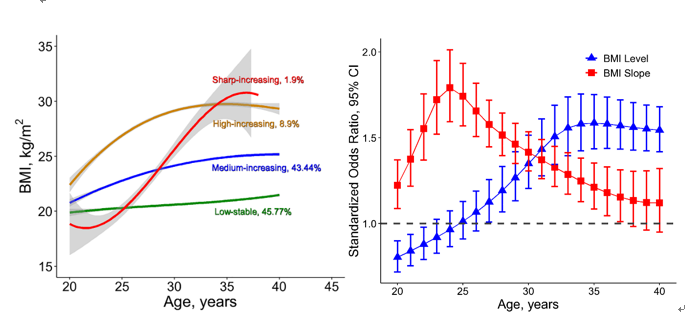Recently, Prof. Zhang Tao's research group at the Department of Biostatistics, School of Public Health made significant progress in the research of life-course epidemiology on Obesity - Induced Hypertension. The research article named “Body Mass Index Trajectories During Young Adulthood and Incident Hypertension: A Longitudinal Cohort in Chinese Population” was published on Journal of the American Heart Association (JAHA, IF=5.096). Meanwhile, invited editorial on this article entitled “Obesity - Induced Hypertension: Heavy on the Accelerator” was published by JAHA. The editorial article explained the possible pathogenesis of obesity-induced hypertension and its significance on public health.
This article is one of the “Life Course Epidemiology” article series in Prof. Zhang Tao's research group. The aim of this study was to characterize longitudinal body mass index (BMI) trajectories during young adulthood (20–40 years) and examine the impact of level‐independent BMI trajectories on hypertension risk, in a longitudinal cohort of Chinese population.The study cohort consisted of 3271 participants who had BMI and blood pressure (BP) repeatedly measured 4 to 11 times and information on incident hypertension. Four distinct trajectory groups were identified using latent class growth mixture model:low‐stable, medium‐increasing, high‐increasing, sharp‐increasing. Model‐estimated levels and linear slopes of BMI were calculated using the model parameters and their first derivatives, respectively. Compared with the low‐stable group, the hazard ratios and 95% CI were 2.42 (1.88, 3.11), 4.25 (3.08, 5.87), 11.17 (7.60, 16.41) for the 3 increasing groups, respectively.
These results indicate that the level‐independent BMI trajectories during young adulthood have significant impact on hypertension risk. BMI slope (change of rate) is a better predictor of incident hypertension. Age between 20 and 30 years is a crucial period for incident hypertension, which has implications for early prevention.

Related reading:
Article:https://www.ahajournals.org/doi/10.1161/JAHA.119.011937
Editorial:https://www.ahajournals.org/doi/10.1161/JAHA.119.012334
Source: School of Public Health
Written by: Fan Bingbing
Edited by: Che Huiqing